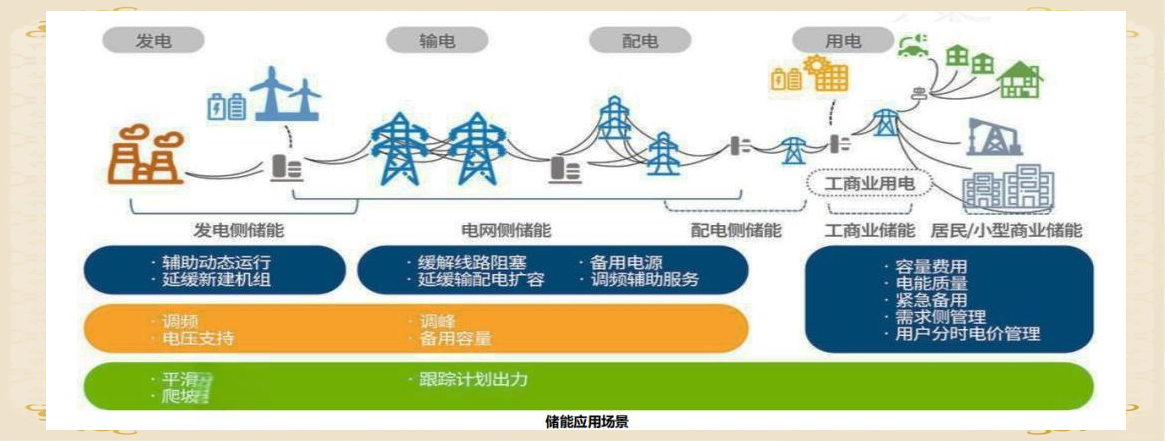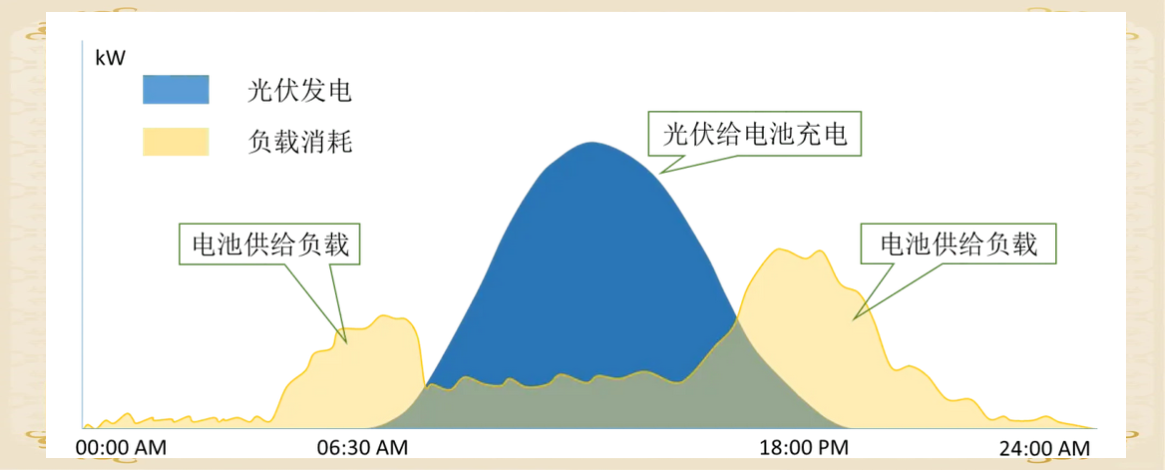Energy storage, in short, is the process of storing energy through specific media or devices and releasing it when needed. This technology can flexibly control charging and discharging, thereby achieving effective matching of production capacity and energy consumption in time and space, providing great flexibility for the power system.
From the perspective of the power system, energy storage can be divided into three main categories: generation side, grid side, and user side. Among them, energy storage on the power source side and grid side is collectively referred to as pre meter energy storage or large-scale energy storage.

Pre meter energy storage, in short, is an energy storage system directly connected to the power grid and equipped with independent power and electricity meters. Relatively speaking, post meter energy storage refers to user side energy storage, also known as household energy storage. User side energy storage is further subdivided into industrial and commercial energy storage and household energy storage. From a business perspective, off balance sheet energy storage should have an independent market entity status, able to independently participate in market quotations, accept dispatch, and settle accounts.
In China, user side energy storage mainly refers to energy storage systems serving industrial and commercial customers, which are similar to large power banks. When electricity prices are low, these systems will charge and store energy; When electricity prices are high, they will be discharged for enterprise production, thereby utilizing the difference in peak and valley electricity prices to reduce the cost of electricity for enterprises.
In addition, there are two technologies: peak shaving and frequency modulation. Peak shaving aims to transfer electricity from affluent areas to scarce areas in order to balance electricity demand. Due to the inability to store electricity on a large scale, it is usually necessary to generate as much electricity as is needed. However, when the electricity generation in a certain region exceeds the local demand, it is necessary to use peak shaving technology to transport the excess electricity to other regions.
On the other hand, frequency regulation is to maintain the stability of the power grid frequency. In China, the rated frequency is 50Hz, but there are many types of electrical appliances used in production and daily life, and their start-up and operation may affect the frequency of the power grid. Therefore, frequency modulation technology is needed to improve power quality and ensure the stable operation of the power grid.
A complete energy storage system includes battery cells, power conversion systems (PCS), battery management systems (BMS), energy management systems (EMS), temperature control equipment, and fire-fighting facilities. Among them, PCS, as the core component of the energy storage system, is responsible for realizing the conversion of electrical energy between the power grid and the battery, and real-time monitoring and management of the conversion process. It can control the charging and discharging of the battery, achieve flexible conversion between AC and DC, and ensure stable power supply for AC loads even without grid power supply. PCS is mainly composed of DC/AC bidirectional converters, control units, etc. Its performance directly affects the operating efficiency and stability of the energy storage system.
The BMS system focuses on monitoring, computing, communication, and protection functions of the battery pack. It monitors and controls the battery status in real-time through battery management chips, analog front-end, embedded microprocessors, and related software, ensuring the safe and efficient operation of the battery.
The EMS system, as the "brain" of the energy storage system, is responsible for real-time monitoring and intelligent management of various devices. It is capable of collecting, storing, processing, and uploading system data, formulating operational strategies, and conducting comprehensive information monitoring and management, providing strong support for the stable operation of energy storage systems.
In addition, "MW" as the power unit of PCS represents the maximum power that an electrochemical energy storage device can input or output at a specific time. And "MWh" is a unit of battery capacity, measuring the amount of electricity that a battery can release under certain conditions, and is an important indicator for evaluating battery performance. Meanwhile, the depth of charge and discharge (DoD) is also a key indicator reflecting the utilization of battery capacity in energy storage systems. It represents the percentage of discharged battery capacity to total capacity, directly affecting the battery's service life and performance.
The four major sources of revenue for industrial and commercial energy storage include:
(1) Peak shaving and valley filling: By utilizing the difference in peak valley electricity prices, companies accumulate charging during valley and peacetime periods, while discharging during peak and off peak periods, effectively reducing their electricity costs. This is currently the main source of revenue for industrial and commercial energy storage, accounting for over 90%.
(2) Balancing demand electricity bills: Energy storage systems can help companies eliminate peak loads and use smoother electricity curves through peak shaving and valley filling strategies, thereby reducing demand electricity bills.
(3) Dynamic Capacity Expansion: When the user's transformer capacity is fixed and the transformer needs to operate beyond its capacity during a certain period of time, it is usually necessary to expand the transformer capacity. However, with the appropriate energy storage system, the load on the transformer can be reduced by discharging during this period, thereby saving the cost of transformer capacity expansion and renovation.
(4) Demand side response: After installing energy storage systems, enterprises can better respond to the needs of the power grid, avoid power restrictions and high electricity bills. On the contrary, they may obtain additional compensation fees by participating in demand response transactions.
How to achieve peak shaving and valley filling through energy storage
Its core is energy time shift. Specifically, it means that enterprises charge and accumulate batteries during periods of low electricity load, and release the stored electricity during periods of high electricity load, thereby achieving peak shaving and valley filling of electricity load.

The energy storage system is like an 'energy reservoir'
It can achieve time transfer of energy. When the output of photovoltaic power generation exceeds the demand for self use, the system will intelligently store the excess electricity in the battery; When photovoltaic power generation is insufficient, it can flexibly extract electrical energy from the battery to meet the demand for electricity load. This mechanism not only optimizes the "peak shaving and valley filling" effect of photovoltaic power sources, but also significantly increases the proportion of spontaneous self use of photovoltaic power generation, thereby reducing electricity costs. At the same time, by reducing carbon emissions, we contribute green energy value to enterprises.
Q: How can industrial and commercial energy storage help enterprises reduce capacity and demand?
A: The reduction of capacity and demand is mainly due to the role of energy storage systems, which can effectively reduce the overall capacity demand of transformers, thereby saving the construction cost of transformer expansion, as well as the fixed capacity electricity bill or maximum demand electricity bill in the later stage. For large industrial electricity users who adopt a two-part electricity pricing system, this means significant electricity cost savings. The two-part electricity pricing system includes electricity pricing and capacity pricing. The former is calculated based on actual electricity consumption, while the latter can be calculated based on fixed transformer capacity or maximum demand. In the end, these two types of electricity bills will be added together to form the total electricity bill payable by the user. By optimizing the use of energy storage systems, enterprises can achieve significant savings in both aspects of electricity bills.
After installing an energy storage system in an enterprise, the system can serve as a substitute by supplying power to the load at a certain power level, thereby smoothing out the peak load power and reducing overall capacity demand. This measure not only reduces the cost of transformer construction, but also lowers the capacity electricity bill in the later stage.
Taking an enterprise equipped with a 300kW energy storage system as an example, under demand based billing, the system can release 300kW of power per month, effectively offsetting the impact of peak loads and increasing the transformer capacity by 300kW. Based on a monthly demand cost of 40 yuan per kilowatt, this energy storage system can save the enterprise 300 × 40=20000 yuan in demand costs per month.
Next, we will explore how industrial and commercial energy storage can achieve dynamic capacity expansion. In traditional mode, when users need transformers to operate at overload during a certain period of time, transformer expansion is usually required. However, this approach is costly. In contrast, dynamic capacity expansion is achieved through the installation of energy storage systems. During periods of transformer overload operation, the energy storage system can discharge to reduce transformer load, thereby avoiding or delaying transformer capacity expansion and renovation. This not only significantly reduces costs, but also brings additional profits for peak valley arbitrage to the enterprise.
Detailed explanation of the top ten application scenarios for industrial and commercial/user side energy storage
Zero carbon smart park+energy storage
In traditional industrial parks, there are numerous devices with high power consumption, and prolonged high load operation leads to high energy consumption of the equipment. To achieve the carbon reduction goal, a large amount of renewable energy is used in the park, but the power supply fluctuation caused by its instability cannot be ignored. At this point, energy storage systems become the key to regulating supply and demand levels. Through the "smart park+energy storage" model, energy storage devices can efficiently collect excess electricity such as solar and wind energy, and feed it back to the power grid during major electricity consumption periods, thereby stabilizing the power grid and ensuring the power supply of the park in emergency situations. In addition, the electricity price difference in China's industrial parks provides unique conditions for peak valley arbitrage of energy storage projects.
Commercial complex+energy storage
Commercial complexes face dual challenges of energy conservation and charging. By adopting energy-saving technologies and equipment, energy consumption can be effectively reduced; The combination of distributed new energy power stations and energy storage equipment can store electrical energy for commercial use, reducing dependence on traditional energy sources. At the same time, energy storage devices also support the installation of charging stations in parking lots, underground garages, etc., providing convenient charging services for new energy vehicles.
Data center+energy storage
Under the promotion of the "dual carbon" strategy, low-carbon data centers have become a new trend in the industry. By utilizing digital and intelligent technologies, distributed energy, energy storage, and load are deeply integrated, establishing an aggregation function for the upper platform of virtual power plants, and integrating data center loads, renewable energy sources, and energy storage into an organic whole. This not only realizes the autonomous use and self-management of energy within the region, but also enhances the economic efficiency, power supply reliability, and system security of power operation through the peak shaving and valley filling, capacity allocation, and other functions of the energy storage system.
Integrated light storage and charging
The integrated solution of photovoltaic energy storage and charging combines photovoltaic power generation, energy storage equipment, and charging piles to achieve efficient utilization of renewable energy and stable operation of the power system. This plan is not only suitable for new construction projects, but also for upgrading and transforming existing projects, providing strong support for promoting the development of green energy and achieving carbon neutrality goals.
Microgrid+energy storage
With the vigorous development of island construction, China is facing the challenge of providing stable electricity for a small number of residents, island guarding militia, mobile signal transmission base stations, maritime radar stations and other facilities. In harsh natural environments, conventional photovoltaic and wind power generation often struggle to meet this demand. However, through the combination of microgrids and energy storage technology, this problem has been effectively solved.
A microgrid is a small power system that deeply integrates distributed energy, energy storage devices, and loads. Through intelligent control and management, microgrids can provide stable and reliable electricity to islands in various environments. Energy storage devices play a crucial role in this, as they can effectively collect and store renewable energy sources such as solar and wind energy, and release them when needed, ensuring the stable operation of microgrids.
This solution is not only suitable for remote areas such as islands, but can also be widely applied to other situations that require stable electricity, such as mountainous areas and remote pastures. By combining microgrids with energy storage, we can achieve efficient utilization of clean energy and provide stable and reliable power support for residents and facilities in remote areas.On this type of island, we have installed an off grid intelligent island microgrid, which achieves precise coordinated control of power generation, energy storage, and consumption conditions through an energy management system. This system can flexibly adjust the connection methods of various users, ensuring the coordinated operation and economy of "source network load storage". This innovative solution not only solves the electricity problem for island residents, but also provides reliable power support for the development and protection of islands and oceans, and valuable technical experience for the construction of smart island microgrids.
In mining areas and other regions, such as oil exploration and coal mining, there is often a lack of reliable and economical power sources. To address this issue, we have installed an energy storage system. When a fault occurs on the grid side or normal maintenance is required, the system can ensure stable power supply on the load side. Through energy storage inverters, the direct current energy in the battery system can be converted into alternating current energy to provide power support for the user side.
In addition, during the process of receiving electricity from the grid on the user side, the system controller will allocate the time periods for user electricity collection and battery energy storage reasonably based on the peak, off peak, and off peak periods of electricity billing. For isolated power grids such as offshore oil fields, their power capacity is small while their load capacity is large. High load start-up or power grid failures can cause frequency fluctuations. By configuring energy storage systems, we can effectively improve the frequency regulation performance of the power system and maintain frequency stability.
High power emergency energy storage power supply is an important branch of the new energy battery industry, similar to a "super sized power bank". This type of power supply is very useful in outdoor scenarios such as RV travel, night fishing, and outdoor camping. At the same time, in the event of a power grid failure, it can also provide power support for emergency rescue, suitable for various occasions such as emergency rescue and hospital backup power supply.
On the other hand, urban rail transit is also exploring the application of energy storage technology. Urban rail transit vehicles generate a large amount of regenerated electrical energy during braking, which can be recovered and utilized by introducing energy storage systems, in line with the requirements and development trend of an energy-saving society. Among them, flywheel energy storage technology has been widely used in urban subways. Flywheel energy storage uses an electric motor to drive the flywheel rotor to rotate at high speed to store energy. It has the characteristics of high power density and long life, and can respond to high-power charging and discharging needs in a short time, ensuring a charging and discharging life of tens of millions of times.


 Shipping products
Shipping products
 Energy storage products
Energy storage products
 Shipping products
Shipping products
 Energy storage products
Energy storage products
 Energy storage plan
Energy storage plan
 Energy storage plan
Energy storage plan





